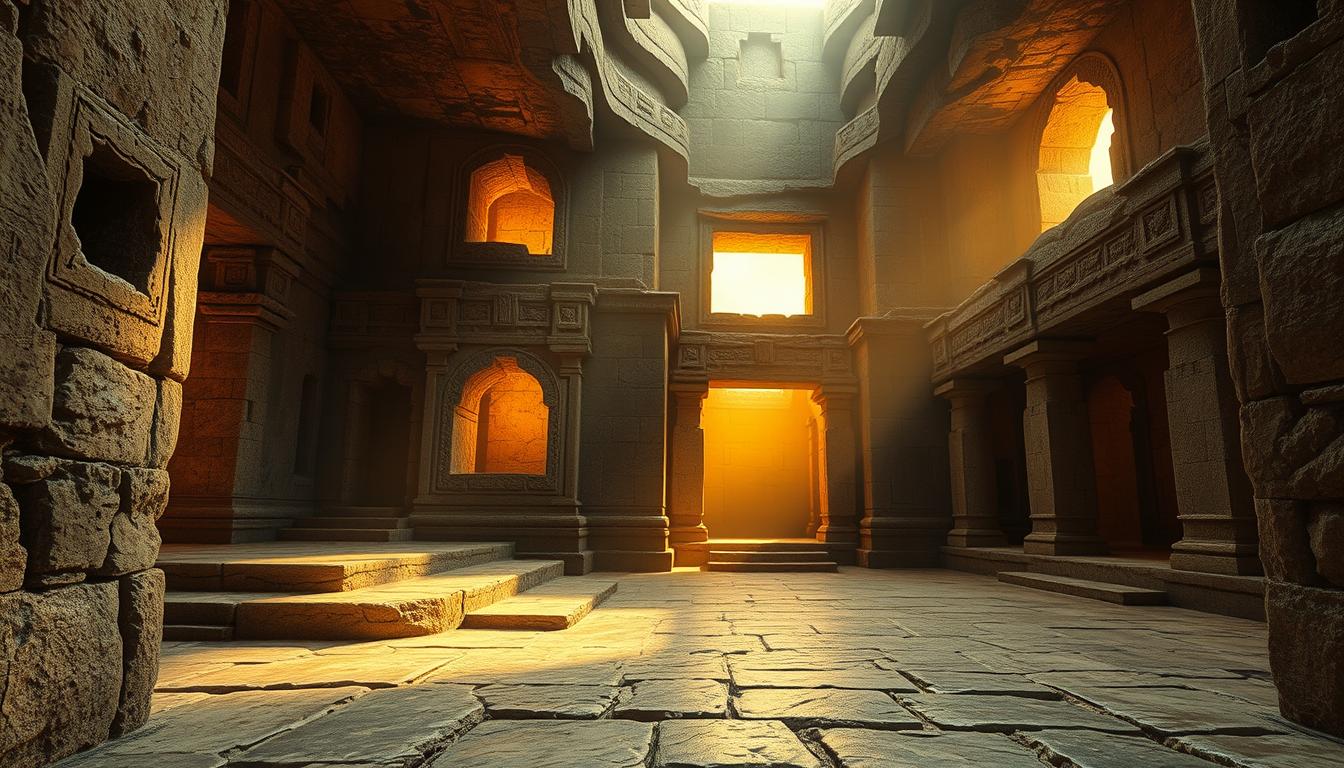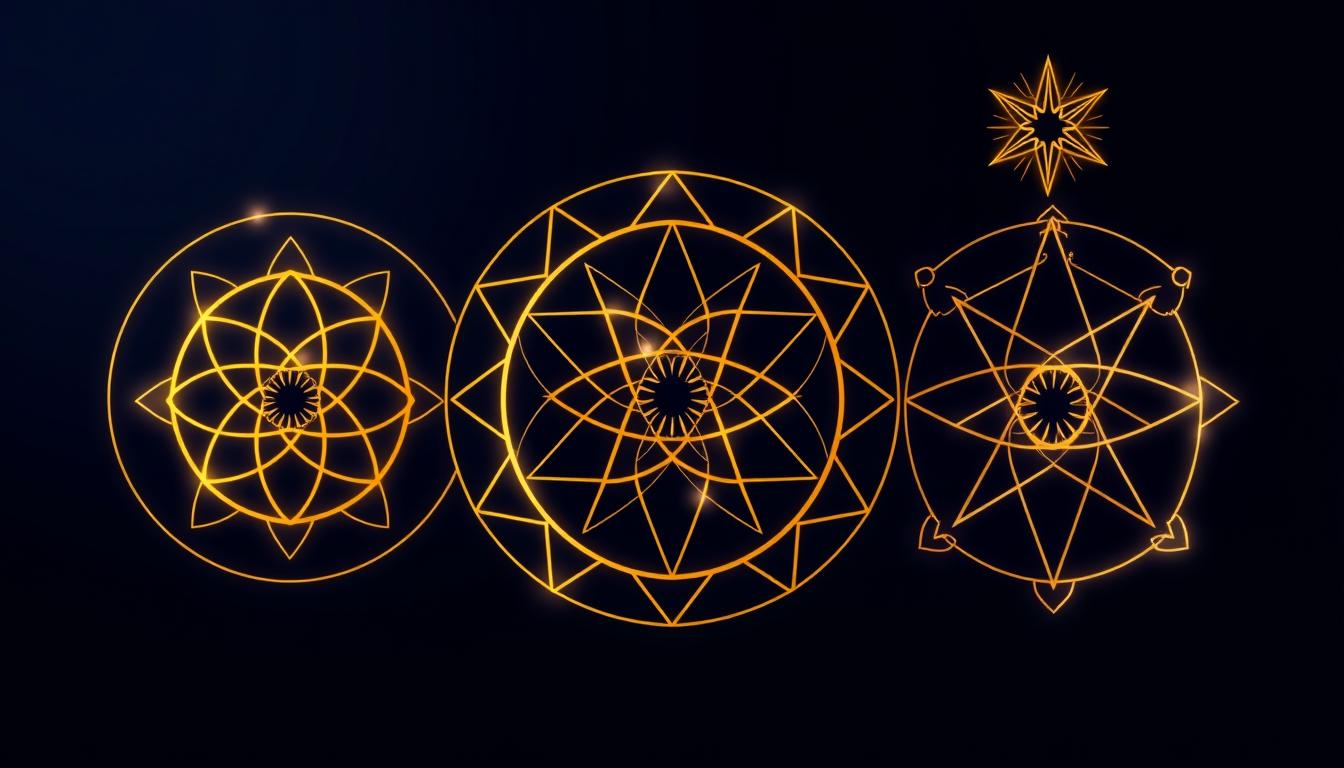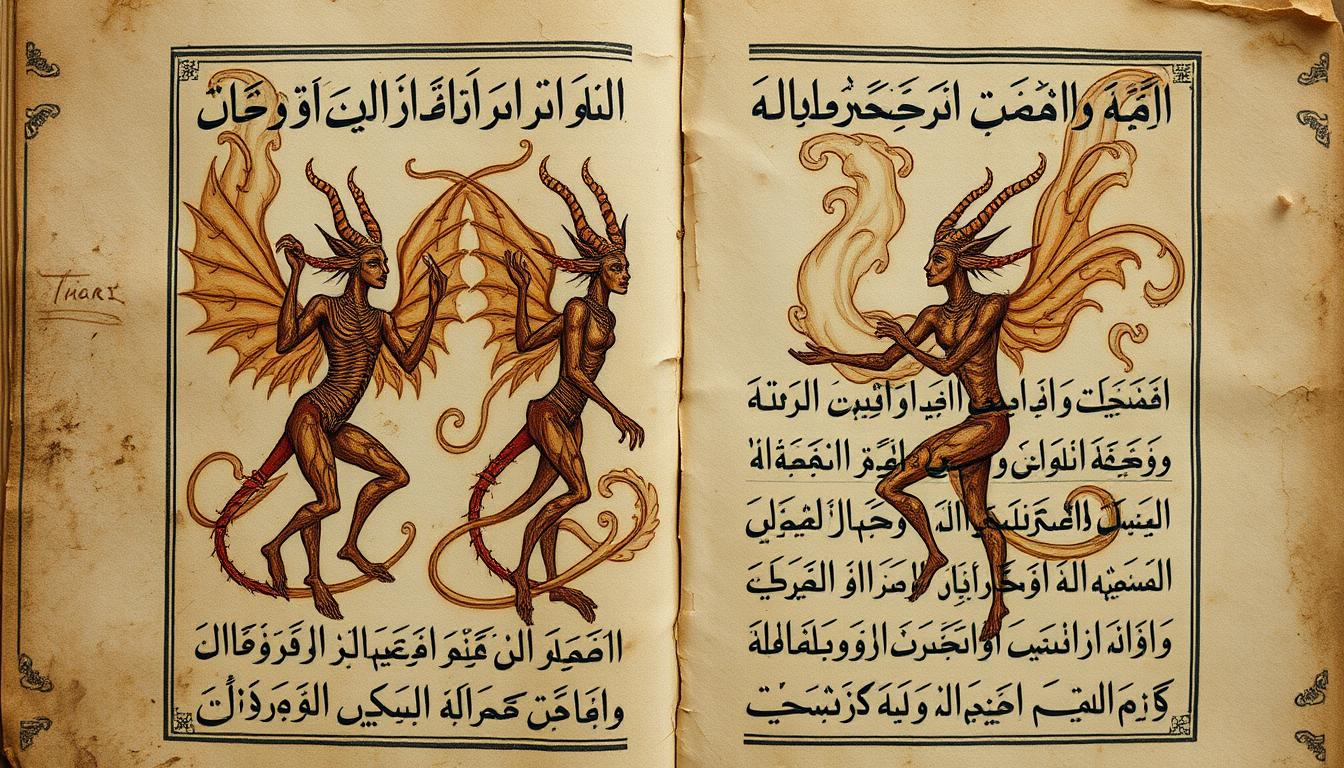
While most commonly associated with Islamic theology, the concept of Djinn extends far beyond a single religious tradition. Their nature as interdimensional beings offers intriguing parallels to modern accounts of alien encounters, archonic influences from Gnostic traditions, and various paranormal phenomena reported across cultures. This exploration will unveil the hidden connections between these seemingly disparate concepts, revealing a tapestry of understanding that spans millennia.
Origins and Definition of the Djinn
Ancient Arabic manuscript depicting the creation of Djinn from smokeless fire
The word “Djinn” (also spelled as jinn, jinni, or genie) derives from the Arabic root meaning “to hide” or “to be hidden from sight.” This etymology perfectly captures their fundamental nature—beings that exist in a dimension parallel to our own, typically invisible to human perception. According to Islamic theology, Djinn represent a third category of sentient creation alongside humans and angels.
While humans were formed from clay and angels from light, the Quran specifically describes Djinn as being created from “smokeless fire” (Quran 15:27). This unique composition grants them abilities beyond human capacity, including shapeshifting, flight, and the power to traverse dimensions. Unlike the popular Western conception of genies bound to lamps and granting wishes, authentic Djinn lore presents them as free-willed beings with their own societies, religions, and moral complexities.
In Islamic tradition, Djinn are neither inherently good nor evil. Like humans, they possess free will and can choose their path. Some follow righteous ways and may even practice Islam, Christianity, or Judaism, while others rebel against divine guidance. The Quran explicitly states that Muhammad was sent as a prophet to both humans and Djinn, indicating their spiritual accountability.
Types of Djinn in Traditional Lore
Traditional classifications of Djinn include several distinct categories, each with unique characteristics:
- Marid – The most powerful class of Djinn, often associated with bodies of water and known for their tremendous strength and pride
- Ifrit – Powerful, cunning Djinn associated with fire, known for their strength and often depicted as malevolent
- Shaitan – Malicious Djinn who actively oppose divine guidance, similar to the concept of demons
- Ghul – Djinn that haunt graveyards and feed on human flesh, shape-shifting to lure victims
- Sila – Djinn that cannot transform completely and retain some animal features when taking human form
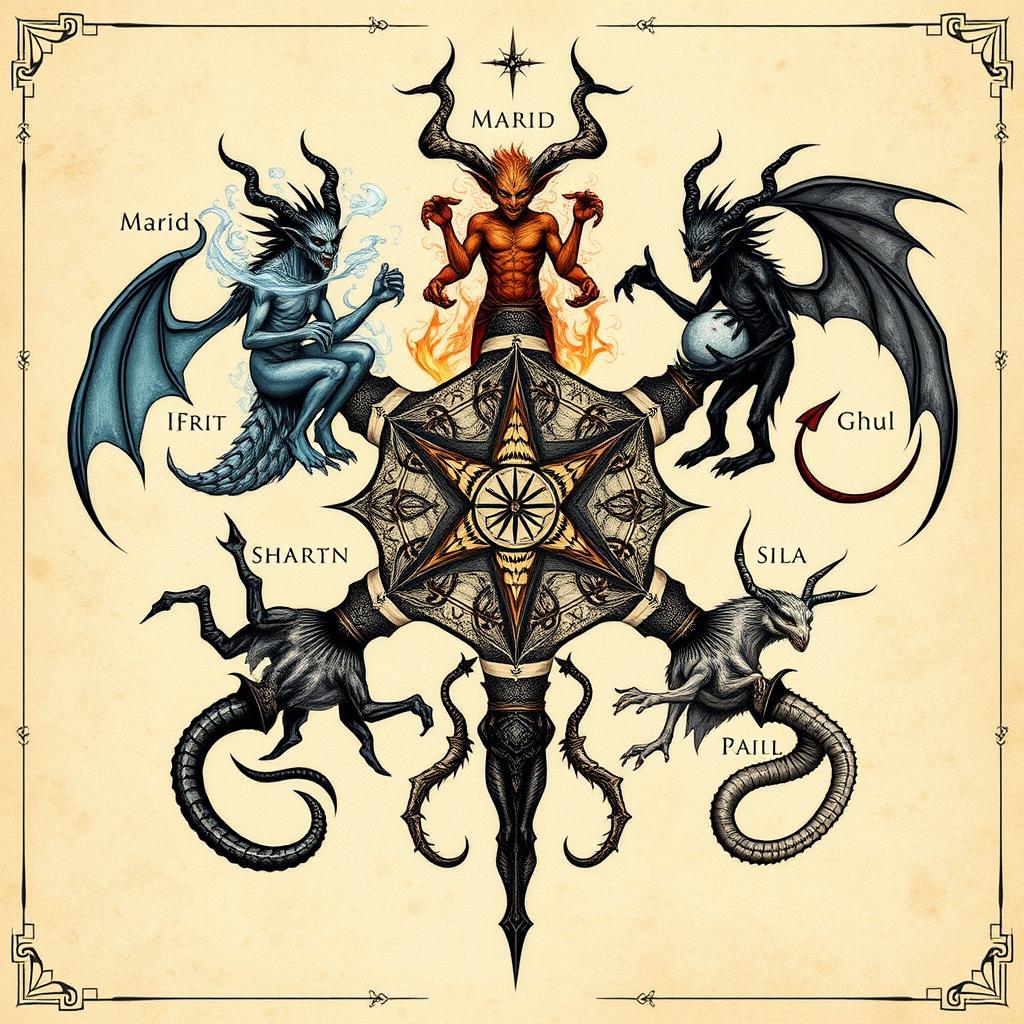
Deepen Your Understanding of Spiritual Entities
Explore our comprehensive guide to interdimensional beings and learn how to recognize their presence in your spiritual practice.
Ancient Civilizations and Their Connection to Djinn
While the Islamic conception of Djinn is perhaps the most well-documented, similar entities appear across numerous ancient civilizations. These parallels suggest that encounters with such beings have been a consistent part of human experience throughout history, merely interpreted through different cultural lenses.
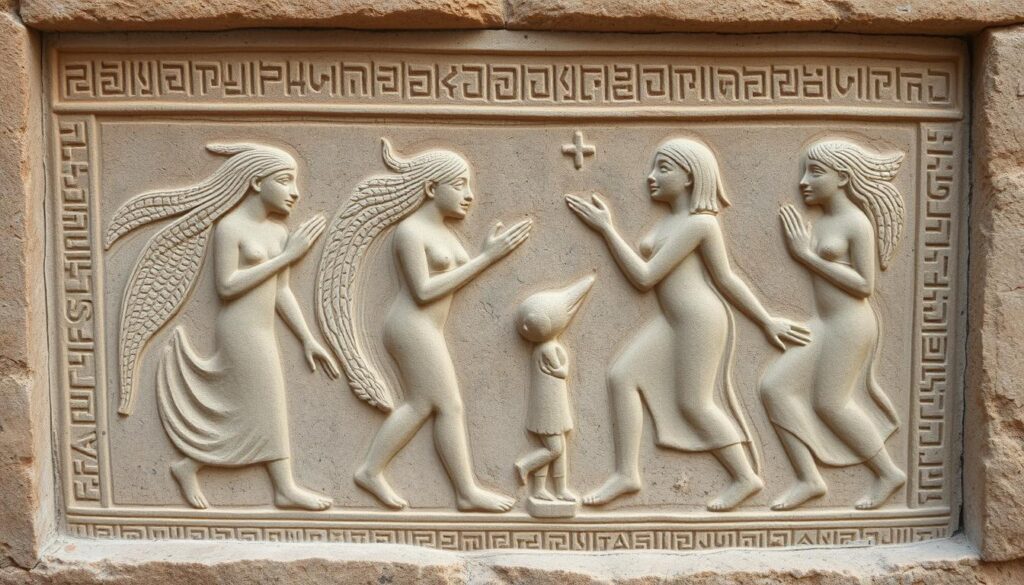
Mesopotamian relief depicting entities similar to Djinn interacting with humans
Mesopotamian Connections
In ancient Mesopotamia, beings known as “utukku” share remarkable similarities with Djinn. These entities were classified as either beneficial or harmful and were believed to inhabit desolate places such as deserts and ruins—precisely the environments traditionally associated with Djinn. The Babylonian “Lilitu” spirits, often female entities that haunted lonely places, also parallel certain aspects of female Djinn in later traditions.
Sumerian texts describe the “Edimmu”—disembodied human spirits that could possess the living and cause illness. While not identical to Djinn, these beings occupied a similar conceptual space as invisible entities that could interact with and influence the physical world. The Akkadian “Shedu” and “Lamassu” were protective spirits that, like certain classes of Djinn, could be benevolent toward humans when properly respected.
Egyptian Mythology and Djinn-like Entities
Ancient Egyptian mythology features numerous spirit beings that share characteristics with Djinn. The “Akh”—transfigured spirits of the deceased—possessed supernatural abilities and could interact with the living world. More directly comparable are the “Bau” spirits, invisible entities that could bring either fortune or misfortune depending on how they were treated.
The Egyptian concept of “Ka”—a spiritual double that exists alongside each person—bears interesting parallels to the Islamic concept of “Qareen,” a type of Djinn assigned to each human being. Both traditions suggest an invisible companion that accompanies a person throughout life, influencing thoughts and actions.
Persian Influences
Pre-Islamic Persian mythology featured the “Divs” and “Peris”—supernatural beings that later influenced Islamic conceptions of Djinn. The Zoroastrian tradition, in particular, developed a complex hierarchy of spiritual beings that included both benevolent and malevolent entities. The term “Jahi” referred to female demons that, like certain female Djinn, were believed to seduce men and cause spiritual corruption.
The Persian “Ahriman” (the destructive spirit in Zoroastrianism) and his demonic forces share conceptual space with the more malevolent categories of Djinn. These connections suggest a cultural exchange of ideas that eventually contributed to the Islamic understanding of Djinn, demonstrating how these concepts evolved across civilizations while maintaining core similarities.
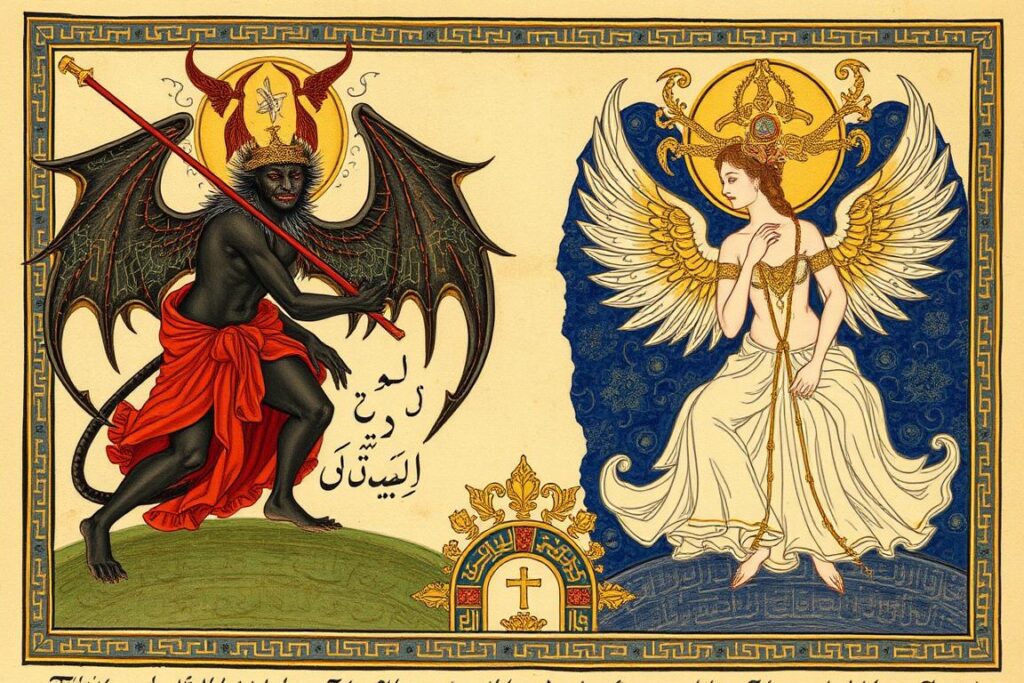
Persian miniature depicting Divs and Peris, supernatural beings that influenced Islamic Djinn concepts
Biblical and Hebrew Connections
In Hebrew traditions, entities known as “Shedim” bear striking similarities to Djinn. These beings are mentioned in the Talmud as created spirits that were left incomplete when God rested on the Sabbath. Like Djinn, they were believed to have physical needs, reproduce, and possess supernatural abilities while remaining largely invisible to humans.
The “Se’irim” mentioned in Leviticus 17:7 as “goat demons” worshipped in the wilderness also parallel the desert-dwelling nature of Djinn. The Hebrew “Lilith,” originally a wind spirit and later developed into a night demon, shares characteristics with certain female Djinn known for haunting desolate places.
Extraterrestrial Theories and Djinn
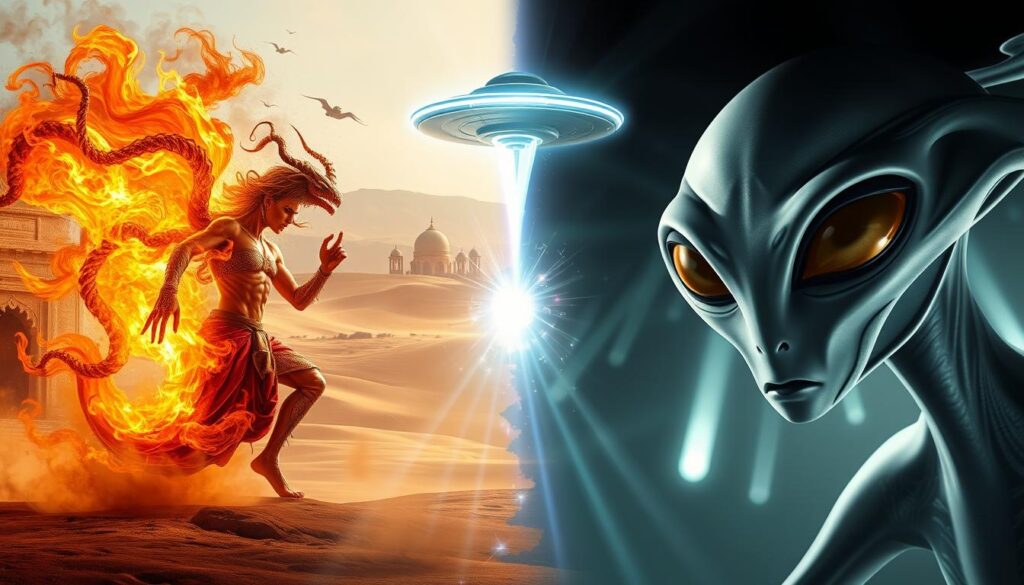
Comparative visualization of traditional Djinn descriptions and modern alien encounter reports
The parallels between traditional Djinn accounts and modern extraterrestrial encounter reports have led some researchers to propose that these phenomena may represent different cultural interpretations of the same entities. This perspective doesn’t necessarily diminish the spiritual significance of Djinn but rather suggests that ancient wisdom traditions may have been describing interdimensional beings through the conceptual framework available at the time.
Phenomenological Similarities
Several key similarities between Djinn encounters and alien abduction reports stand out:
- Sudden paralysis – Both Djinn attacks and alien encounters often begin with the victim experiencing sleep paralysis or an inability to move
- Missing time – Periods of lost time are reported in both Djinn encounters and alien abduction scenarios
- Telepathic communication – Both entities are frequently described as communicating without speaking
- Ability to pass through solid objects – Both Djinn and aliens are reported to move through walls and closed doors
- Manipulation of human reproduction – Stories of Djinn mating with humans parallel alien hybrid programs in abduction accounts
- Technological manipulation – Both entities are associated with electrical disturbances and technology malfunctions
“The similarities between Djinn encounters and modern alien abduction reports are too numerous to dismiss as coincidence. Both phenomena may represent human interactions with the same interdimensional intelligence, interpreted through the cultural lens of the experiencer.”
The Interdimensional Hypothesis
Rather than literal extraterrestrials from distant planets, some researchers propose that both Djinn and “aliens” may be interdimensional beings that have always coexisted with humanity. This theory, popularized by researchers like Jacques Vallée and John Keel, suggests that these entities access our reality through dimensional portals or during specific electromagnetic conditions.
The Djinn’s traditional association with specific locations (ruins, deserts, crossroads) might indicate places where the veil between dimensions is naturally thinner. Similarly, UFO hotspots often feature unusual electromagnetic properties or geological formations that could theoretically facilitate interdimensional contact.
Technological vs. Magical Frameworks
The primary difference between traditional Djinn accounts and modern alien encounters may simply be the interpretive framework. Ancient cultures understood these experiences through a magical or spiritual paradigm, while contemporary witnesses often employ technological explanations. The entities themselves may be unchanged, but our conceptual vocabulary for describing them has evolved.
Where ancient witnesses might describe Djinn traveling on the wind, modern accounts might reference anti-gravity propulsion. Traditional descriptions of Djinn shapeshifting find parallels in reports of aliens using holographic technology or mind control to alter their appearance. In both cases, the underlying phenomenon may be identical, merely filtered through different cultural expectations.
Spiritual Hierarchies: Djinn, Archons, and Beyond
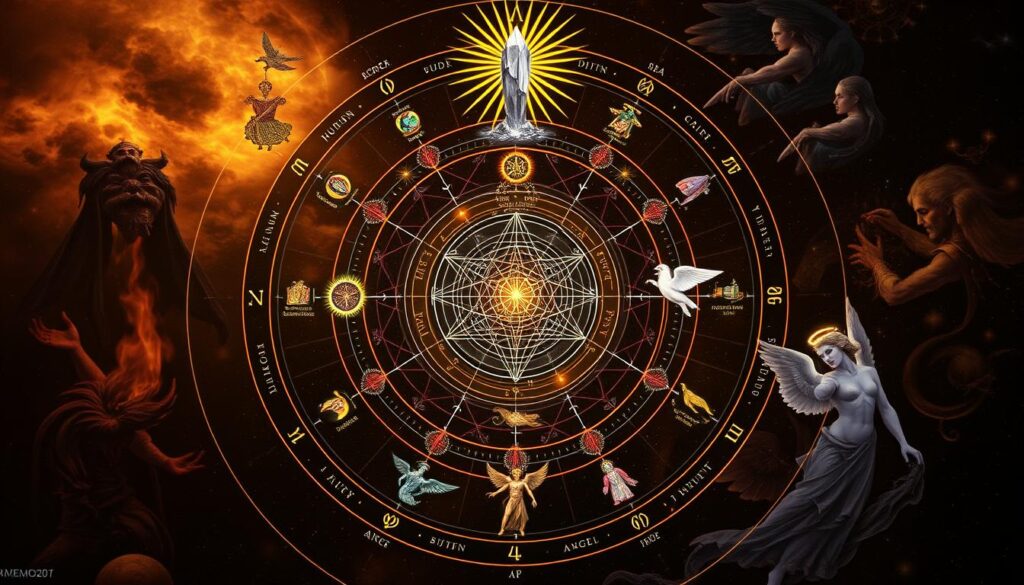
Conceptual representation of spiritual hierarchies including Djinn, Archons, and other metaphysical beings
The Djinn occupy a fascinating position within broader spiritual hierarchies described across various traditions. By examining these relationships, we gain deeper insight into how different cultures have mapped the invisible realms and their inhabitants.
Djinn and Archons: Comparative Analysis
The Gnostic concept of Archons presents particularly striking parallels to certain aspects of Djinn lore. Archons, described in Gnostic texts as the servants of the Demiurge (the false creator god), were believed to be interdimensional beings that could influence human consciousness and trap souls in the material realm.
Key similarities between Djinn and Archons include:
- Interdimensional nature – Both exist in realms adjacent to our physical reality
- Ability to influence human thought – Both can affect human consciousness and behavior
- Hierarchical organization – Both are described as having complex social structures and ranks
- Limitation by divine law – Neither can override human free will completely
- Association with specific elements – Djinn with fire, Archons with crystalline or metallic forms
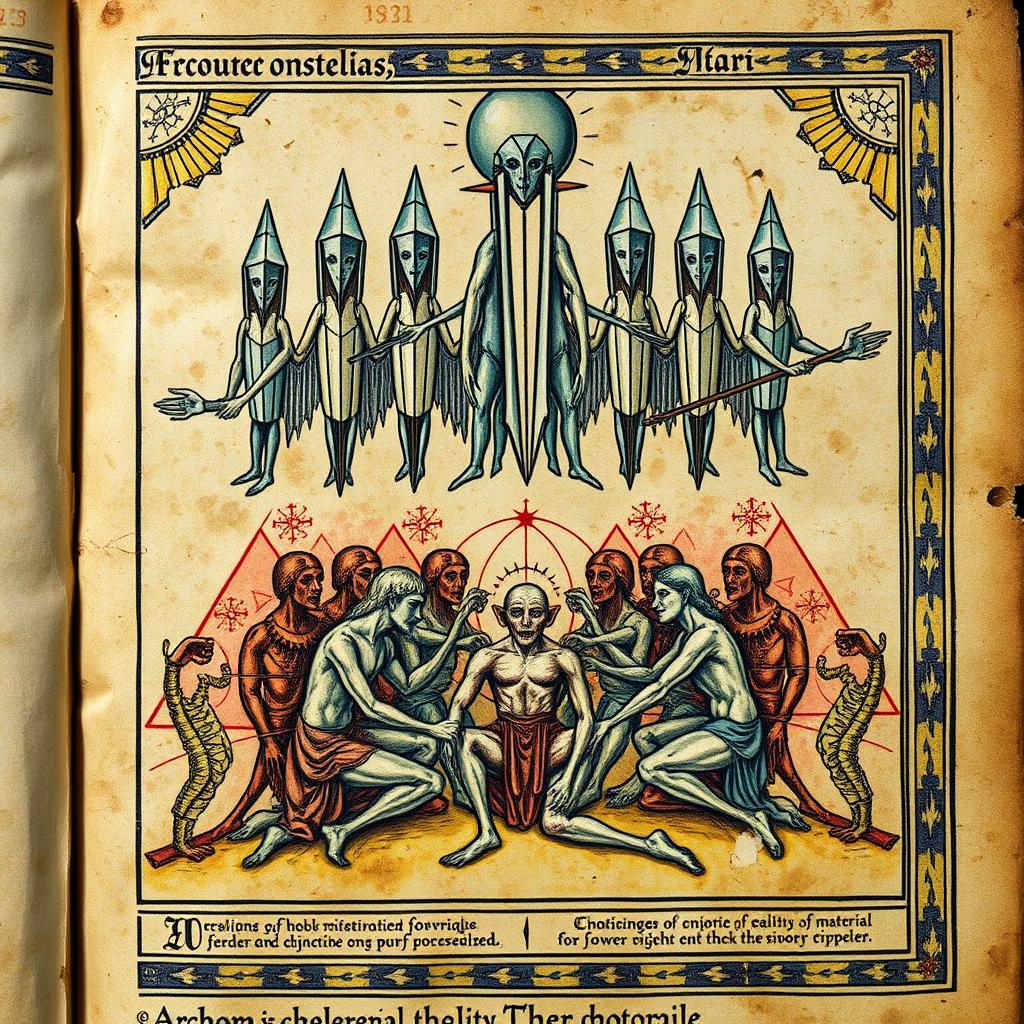
Gnostic representation of Archons as controllers of material reality
The primary difference lies in their origin stories and moral alignment. While Djinn are created by the same divine source as humans and possess moral agency, Archons are typically portrayed as inherently opposed to human spiritual liberation. Nevertheless, both concepts describe non-physical intelligences that interact with humanity from adjacent dimensions.
Elemental Beings and Nature Spirits
In Western esoteric traditions, elemental beings (sylphs of air, salamanders of fire, undines of water, and gnomes of earth) share conceptual space with certain categories of Djinn. The salamanders, in particular, parallel fire Djinn like the Ifrit, while air elementals resemble the more ethereal classes of Djinn.
Celtic traditions speak of the Sidhe or Faery folk—beings that dwell in a parallel dimension yet can interact with our world. Like Djinn, they were believed to occasionally interbreed with humans, creating offspring with unusual abilities. The “fairy rings” and special hills associated with the Sidhe mirror the specific locations traditionally linked to Djinn activity.
Angelic and Demonic Hierarchies
In Abrahamic traditions, Djinn occupy a middle position between angels and demons. Unlike angels, who are created from light and lack free will, Djinn possess moral agency similar to humans. Yet unlike demons (fallen angels in Christian tradition), Djinn are not inherently corrupted beings but rather a separate creation with their own spiritual journey.
This middle position makes them particularly interesting in comparative religious studies. The Islamic understanding of Iblis (Satan) as a rebellious Djinn rather than a fallen angel creates a unique theological framework that differs from Christian demonology while sharing certain structural elements.
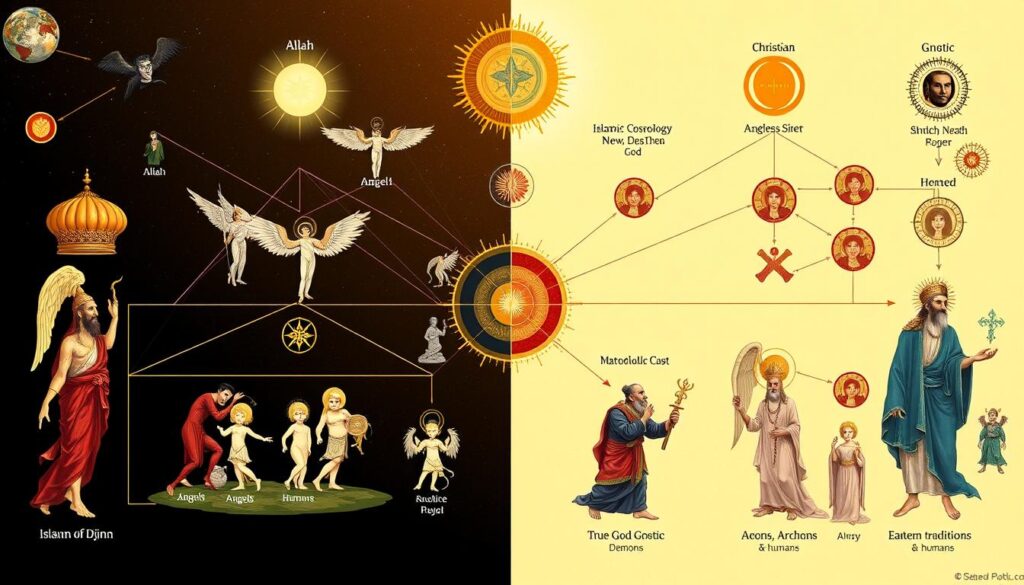
Comparative view of spiritual hierarchies across different world traditions
Shadow People and Interdimensional Beings
Modern paranormal research has documented encounters with “shadow people”—dark, humanoid figures that appear peripherally and vanish when directly observed. These entities share several characteristics with certain classes of Djinn, particularly their ability to appear and disappear suddenly and their tendency to observe humans from the edges of perception.
Similarly, the “Men in Black” phenomenon—mysterious figures who allegedly intimidate UFO witnesses—bears comparison to certain Djinn encounters where witnesses are warned against sharing their experiences. In both cases, the entities seem to enforce some form of silence regarding their existence, suggesting a desire to remain hidden from general human awareness.
Historical Accounts and Paranormal Evidence
Throughout history, documented encounters with Djinn-like entities provide fascinating insights into how these experiences have been interpreted across different time periods and cultures. These accounts, while filtered through cultural expectations, reveal consistent patterns that suggest genuine interaction with non-ordinary intelligences.
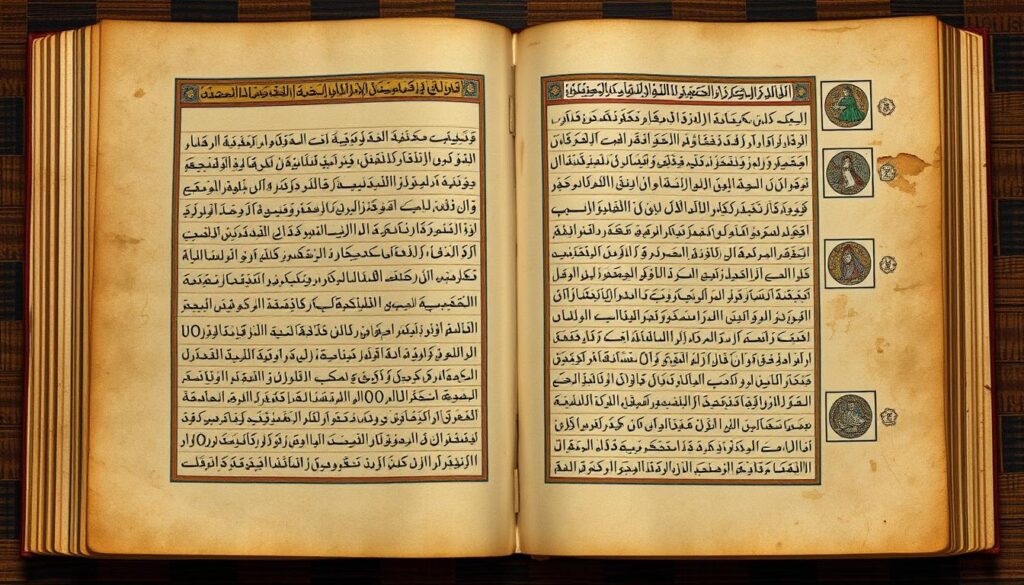
Historical manuscript documenting a Djinn encounter with scholarly annotations
Notable Historical Encounters
Several well-documented historical cases stand out:
- The Zanzibar Incident (1873) – British colonial records describe an entire village experiencing simultaneous poltergeist activity attributed to Djinn, with objects moving independently and disembodied voices heard by multiple witnesses
- The Cairo Haunting (1910) – A well-documented case where a British archaeological team experienced numerous paranormal phenomena after disturbing an ancient site, including apparitions and physical attacks attributed to guardian Djinn
- The Moroccan Cave Expedition (1931) – French anthropologists documented strange lights, voices, and temporary paralysis affecting their research team while exploring caves traditionally associated with Djinn activity
- The Tehran Hospital Case (1962) – Medical records document a patient speaking languages unknown to them during what was described as a Djinn possession, with multiple staff witnesses
“What makes these historical accounts particularly compelling is the consistency of reported phenomena across cultures and time periods, often documented by educated observers with no prior belief in such entities.”
Physical Evidence and Paranormal Phenomena
While the non-physical nature of Djinn makes direct evidence challenging, certain physical phenomena have been consistently associated with their presence:
- Electrical disturbances – Malfunctioning electronics, light bulbs burning out, and battery drainage
- Temperature anomalies – Sudden cold spots or unusual heat in specific locations
- Unexplained scents – Particularly burning sulfur or unusual fragrances appearing and disappearing
- Physical marks – Scratches, burns, or bruises appearing on witnesses after reported encounters
- Poltergeist activity – Objects moving, falling, or breaking without apparent cause
- EVP recordings – Electronic Voice Phenomena capturing languages or dialects unknown to present individuals
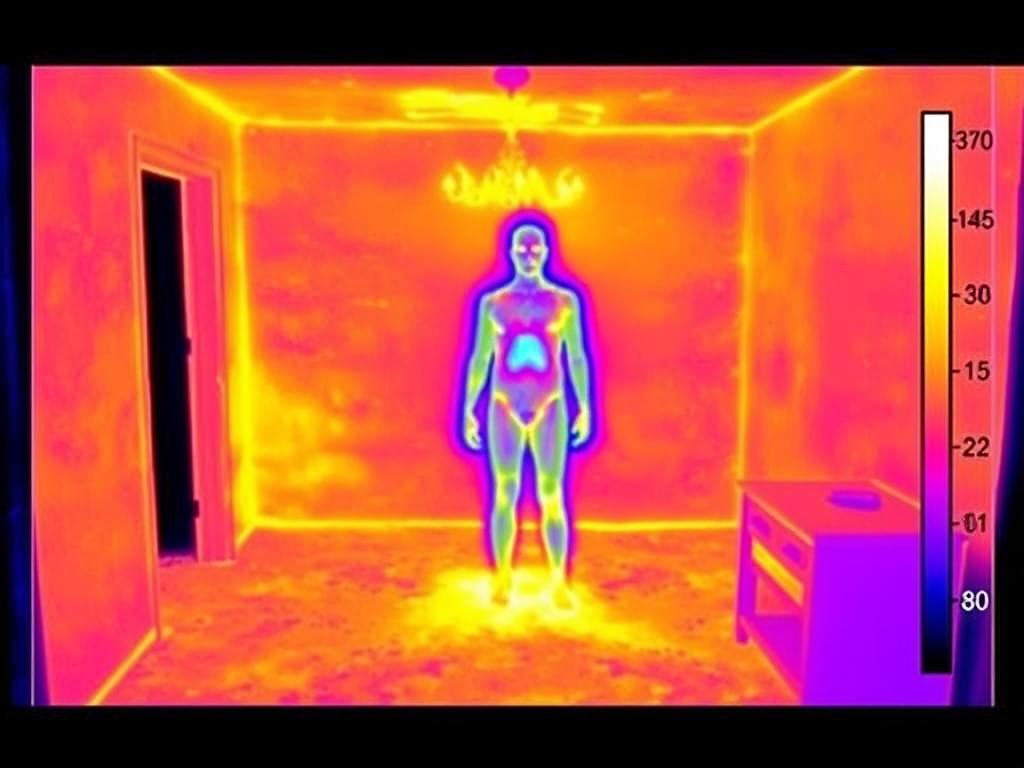
Thermal imaging showing temperature anomaly associated with reported Djinn activity
Cross-Cultural Case Studies
Modern paranormal research has documented numerous cases that, while not explicitly labeled as Djinn encounters by the witnesses, share remarkable similarities with traditional accounts:
In 2008, a family in Salalah, Oman documented a series of escalating phenomena in their home, beginning with electrical disturbances and culminating in physical attacks and apparent possession. Local religious authorities identified the cause as a disturbed Djinn and performed traditional remedies, after which the phenomena ceased.
A 2015 case from Indonesia involved a mining operation that encountered inexplicable equipment failures and worker illnesses after expanding into an area traditionally considered sacred to local Djinn. After performing ceremonial appeasements suggested by indigenous elders, the problems mysteriously resolved.
In 2019, paranormal investigators in New Mexico documented phenomena in an abandoned mining town that local Native American traditions attributed to non-human entities dwelling in the mountains. The investigators recorded unexplained voices speaking archaic Spanish and Navajo, languages unknown to team members.
Modern Metaphysical Interpretations
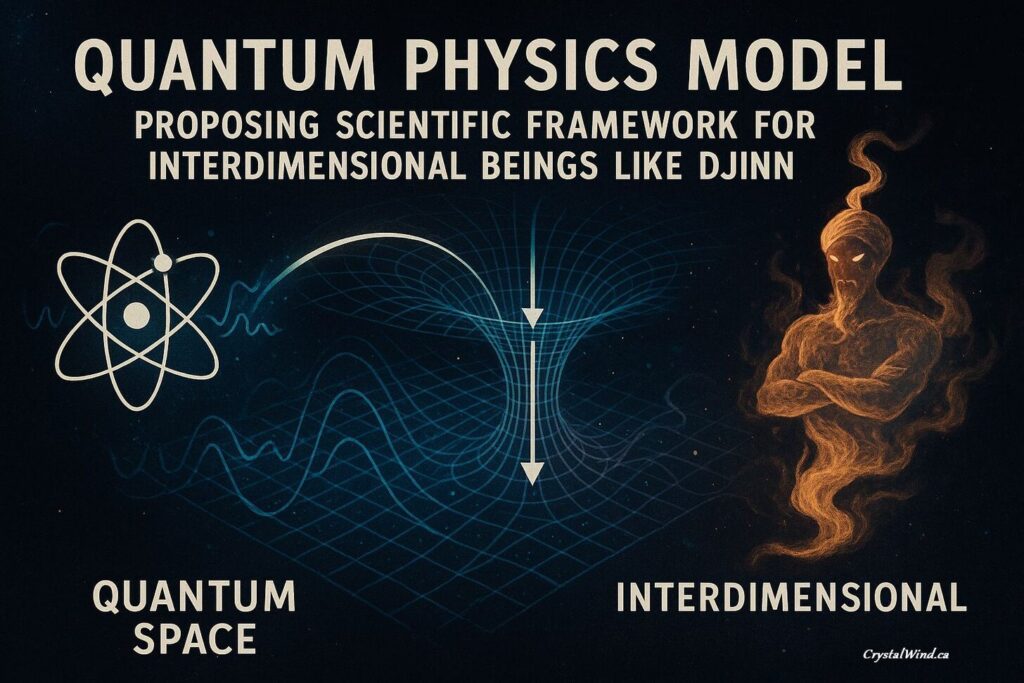
Quantum physics model proposing scientific framework for interdimensional beings like Djinn
Contemporary metaphysical thought has developed sophisticated frameworks for understanding Djinn and similar entities, often integrating traditional wisdom with modern scientific concepts. These interpretations offer new perspectives on ancient knowledge while providing practical approaches for those who encounter such phenomena.
Quantum Perspectives on Interdimensional Beings
Modern physics, particularly quantum mechanics and string theory, has opened theoretical possibilities for understanding how beings like Djinn might exist. The concept of multiple dimensions beyond our perceivable three-dimensional space provides a scientific framework for the “hidden world” described in traditional Djinn lore.
Quantum superposition—the principle that particles can exist in multiple states simultaneously until observed—offers an intriguing parallel to the Djinn’s ability to remain invisible yet affect physical reality. Some theorists propose that Djinn may exist in a quantum state that allows them to interact with our dimension without being fully present within it.
The “observer effect” in quantum physics, where the act of observation affects the phenomenon being observed, might explain why Djinn encounters often occur in altered states of consciousness or liminal spaces where human perception is shifted from ordinary awareness.
Consciousness-Based Models
Several consciousness-based models have been proposed to explain Djinn and similar phenomena:
- Morphic Resonance – Rupert Sheldrake’s theory suggests that Djinn might represent consciousness fields that have developed over millennia through collective human experience
- Holographic Universe – If reality is fundamentally informational rather than material, Djinn might represent coherent information patterns that can interact with human consciousness
- Psychoid Archetypes – Carl Jung’s concept of archetypes that exist at the boundary between mind and matter might explain entities that seem both psychological and objectively real
- Bioelectric Field Theory – Djinn might interact with the human bioelectric field, explaining their effects on emotional states and physical sensations
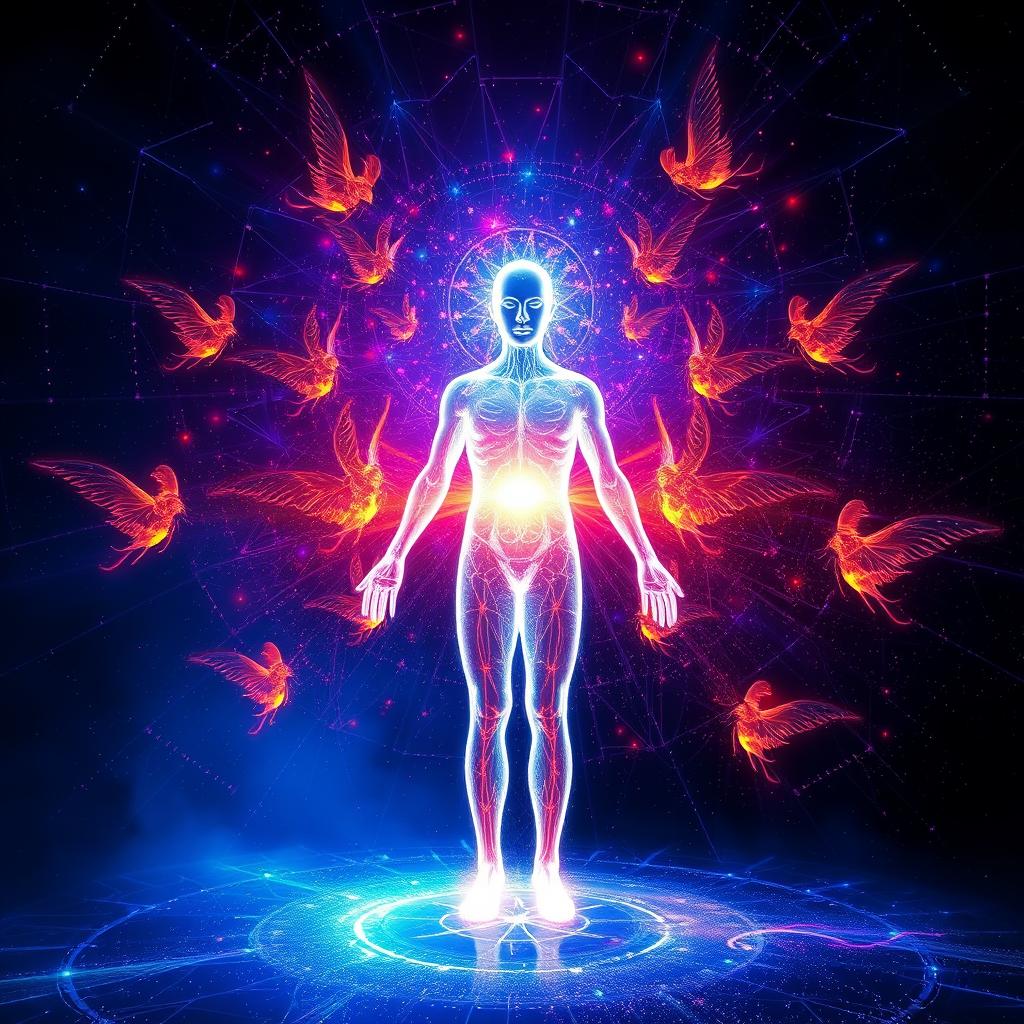
Visualization of human consciousness field interacting with interdimensional entities
Energy-Based Interpretations
Many modern metaphysical practitioners conceptualize Djinn as complex energy patterns rather than discrete entities. This perspective views them as conscious energy forms that exist at different vibrational frequencies than physical matter, explaining their ability to affect electromagnetic fields and human energy systems.
The traditional description of Djinn as created from “smokeless fire” aligns with this energy-based interpretation, as fire represents transformation and energy in many esoteric systems. Their reported ability to affect emotional states and physical sensations can be understood as interactions between their energy patterns and human bioelectric fields.
Some practitioners report being able to perceive Djinn as specific energy signatures through developed clairvoyant abilities. These signatures often appear as swirling patterns of colored light or heat distortions in the visual field, consistent with traditional descriptions of their fiery nature.
Psychological and Transpersonal Perspectives
Transpersonal psychology offers frameworks for understanding Djinn encounters as genuine interactions with non-ordinary aspects of consciousness. Rather than dismissing such experiences as hallucinations, this approach acknowledges that consciousness may extend beyond the individual mind to include encounters with autonomous intelligences.
The concept of “psychic intrusion” in clinical parapsychology provides a model for understanding negative Djinn encounters. This perspective suggests that certain mental states may make individuals more vulnerable to influence from external consciousness forms, explaining the association between Djinn encounters and liminal states like sleep paralysis.
Some Jungian analysts have proposed that Djinn represent autonomous complexes within the collective unconscious that have developed independent consciousness through millennia of human belief and interaction. This doesn’t reduce them to “mere psychology” but rather acknowledges the power of consciousness to generate real effects in both subjective and objective reality.
Practical Guidance for Spiritual Practitioners
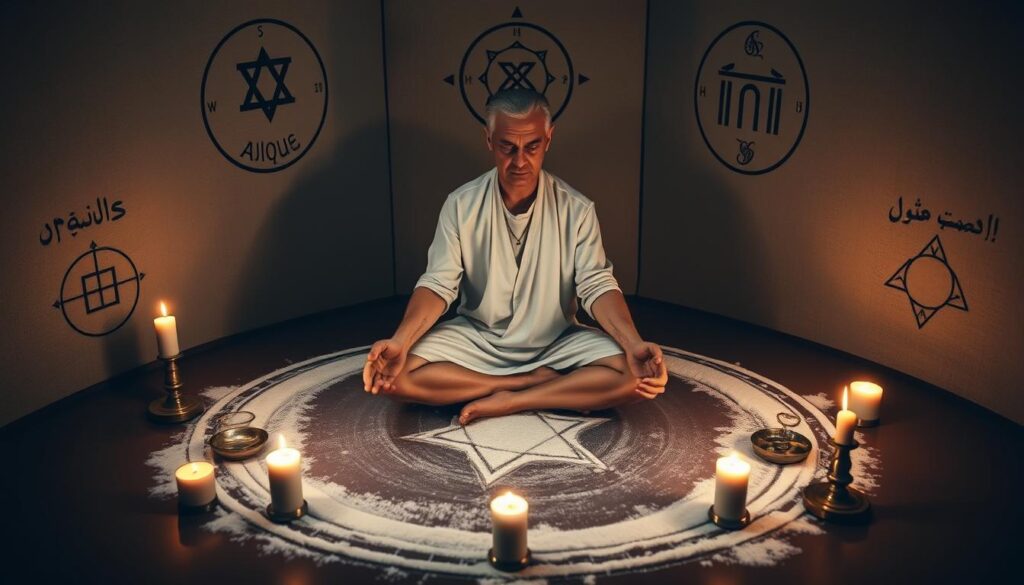
Spiritual practitioner performing protection ritual with sacred symbols from multiple traditions
For those who work within spiritual and metaphysical frameworks, understanding how to navigate potential encounters with Djinn and similar entities is essential. The following guidance draws from traditional wisdom across cultures while incorporating modern metaphysical understanding.
Recognition and Discernment
Learning to recognize potential Djinn presence is the first step in appropriate response:
- Sudden emotional shifts – Unexplained feelings of dread, anger, or obsessive thoughts that seem foreign to your normal patterns
- Recurring dreams – Especially those featuring unknown entities or visits to unfamiliar places
- Unusual sensory experiences – Particularly unexplained scents, sounds, or peripheral visual phenomena
- Electronic disturbances – Patterns of equipment failure, especially during meditation or spiritual work
- Synchronicities – Meaningful coincidences that seem designed to communicate specific messages
- Physical symptoms – Unexplained marks, sensations of being touched, or localized temperature changes
Discernment Practice
When experiencing unusual phenomena, practice this simple discernment technique:
- Center yourself through three deep breaths
- Mentally ask: “Is this presence serving my highest good?”
- Pay attention to your immediate bodily response (tension indicates caution)
- Visualize your personal energy field becoming brighter
- Notice if the phenomena intensifies or recedes with this visualization
Protection Protocols
Across traditions, certain protective practices have proven effective when dealing with unwanted entity contact:
- Sacred sound – Recitation of prayers, mantras, or divine names from your tradition
- Energetic boundaries – Visualization of protective light surrounding your space
- Elemental cleansing – Using salt, water, smoke, or sound to clear spaces
- Sacred geometry – Drawing or placing protective symbols appropriate to your tradition
- Intention setting – Clearly stating boundaries about what energies are welcome in your space
- Physical cleanliness – Maintaining order and cleanliness in living spaces

Protective tools from various traditions used in spiritual boundary work
Respectful Communication
If you believe you’re experiencing contact with Djinn or similar entities, traditional wisdom suggests approaching the situation with respect rather than fear:
- State clear boundaries – Calmly but firmly express what interactions are acceptable
- Avoid provocative actions – Don’t challenge, mock, or attempt to command entities
- Acknowledge their autonomy – Like humans, these beings have their own agency and purposes
- Consider their perspective – You may be intruding in their space rather than vice versa
- Seek mediation if needed – In persistent cases, consult spiritual authorities in your tradition
Important Safety Note
Always rule out physical and psychological explanations before assuming paranormal causes. Carbon monoxide, infrasound, electromagnetic fields, and certain medical conditions can produce experiences similar to entity encounters. Safety first—check physical causes and consult appropriate healthcare providers when experiencing unusual phenomena.
Integration and Understanding
For those who work consciously with non-ordinary states of consciousness, encounters with Djinn-like entities can offer opportunities for spiritual growth when approached mindfully:
- Journal experiences – Document encounters with attention to details, emotions, and insights received
- Look for patterns – Notice if encounters correlate with specific practices, locations, or life circumstances
- Seek wisdom – Consider what these experiences might be revealing about reality’s multidimensional nature
- Maintain sovereignty – Remember that you have the right and ability to set boundaries in all dimensions
- Share appropriately – Discuss experiences with knowledgeable mentors rather than those who might dismiss or sensationalize them
Conclusion: Bridging Ancient Wisdom and Modern Understanding
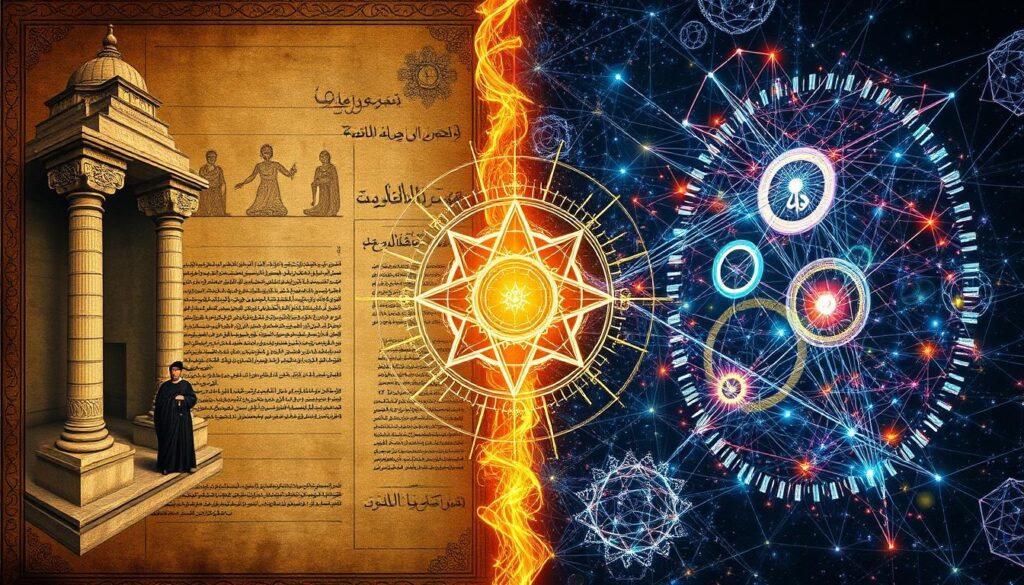
The convergence of ancient wisdom and modern understanding in our approach to interdimensional beings
The study of Djinn and related phenomena represents a fascinating intersection of ancient wisdom traditions and contemporary metaphysical understanding. Rather than dismissing these accounts as mere superstition or reducing them entirely to psychological projections, an integrative approach acknowledges the possibility that humans have been interacting with non-ordinary intelligences throughout history, interpreting these encounters through available cultural frameworks.
Whether understood as literal beings of smokeless fire, interdimensional entities, manifestations of collective consciousness, or aspects of a multidimensional cosmos, the Djinn tradition offers valuable insights into the nature of reality beyond ordinary perception. The remarkable consistency of reported phenomena across cultures and throughout history suggests that something genuine lies at the heart of these accounts.
For spiritual practitioners, the wisdom embedded in traditional approaches to Djinn—emphasizing respect, boundaries, and discernment rather than fear or control—remains relevant regardless of how we conceptualize these experiences. In navigating the mysteries of consciousness and the unseen dimensions that may surround us, ancient traditions offer tested protocols that continue to serve those who explore these frontiers.
Perhaps most importantly, the study of Djinn invites us to maintain an open mind about the true nature of reality. In a universe where quantum physics reveals strange and counter-intuitive truths about the fundamental nature of existence, the possibility of conscious intelligences that exist beyond our ordinary perception becomes less fantastic and more worthy of serious consideration.
As we continue to explore both the depths of consciousness and the frontiers of physical science, the ancient wisdom regarding Djinn and similar beings may prove to be not just fascinating folklore but valuable knowledge about aspects of reality that we are only beginning to scientifically understand.
Frequently Asked Questions About Djinn
Are Djinn the same as demons in Western traditions?
No, Djinn are not equivalent to demons in Western religious traditions. While demons in Christianity are typically understood as fallen angels who are inherently evil, Djinn in Islamic tradition are morally neutral beings with free will, similar to humans. They can choose to be righteous or wicked. Some Djinn may behave in ways similar to what Western traditions would call demonic, but as a category, they are more complex and morally diverse than the Western concept of demons.
How can I tell if I’ve encountered a Djinn?
Traditional signs of Djinn encounters include unexplained sensory phenomena (particularly unusual scents or sounds), electrical disturbances, sudden emotional shifts, recurring dreams of unfamiliar beings or places, and in some cases, physical effects like unexplained marks or sensations of being touched. However, it’s important to rule out natural explanations first, including carbon monoxide exposure, electromagnetic fields, and medical conditions that can produce similar experiences.
Can Djinn possess humans?
In traditional belief systems, particularly Islamic theology, Djinn are believed capable of influencing or possessing humans under certain circumstances. Modern interpretations might describe this as a form of consciousness intrusion or energetic attachment rather than literal possession. Most traditions emphasize that such influence requires some form of invitation or vulnerability and that humans can protect themselves through spiritual practices, clear boundaries, and maintaining psychological well-being.
What’s the difference between Djinn and the popular concept of genies?
The Western pop culture concept of genies (as seen in stories like Aladdin) is a highly simplified and distorted version of the Djinn. Traditional Djinn are not bound to lamps or objects, do not typically grant wishes, and are complex, free-willed beings with their own societies and motivations. The wish-granting, lamp-dwelling genie is largely a Western invention that bears little resemblance to authentic Djinn lore from Islamic and pre-Islamic traditions.
How do different cultures protect themselves from negative Djinn influences?
Protection practices vary across cultures but share common elements: recitation of sacred texts or prayers (such as Quranic verses in Islamic tradition), use of protective symbols (like the Hand of Fatima), cleansing with elements like salt, water, or smoke, maintaining physical cleanliness of living spaces, and setting clear intentions about what energies are welcome. Many traditions also emphasize that maintaining strong spiritual practice and psychological well-being creates natural protection against unwanted influences.


